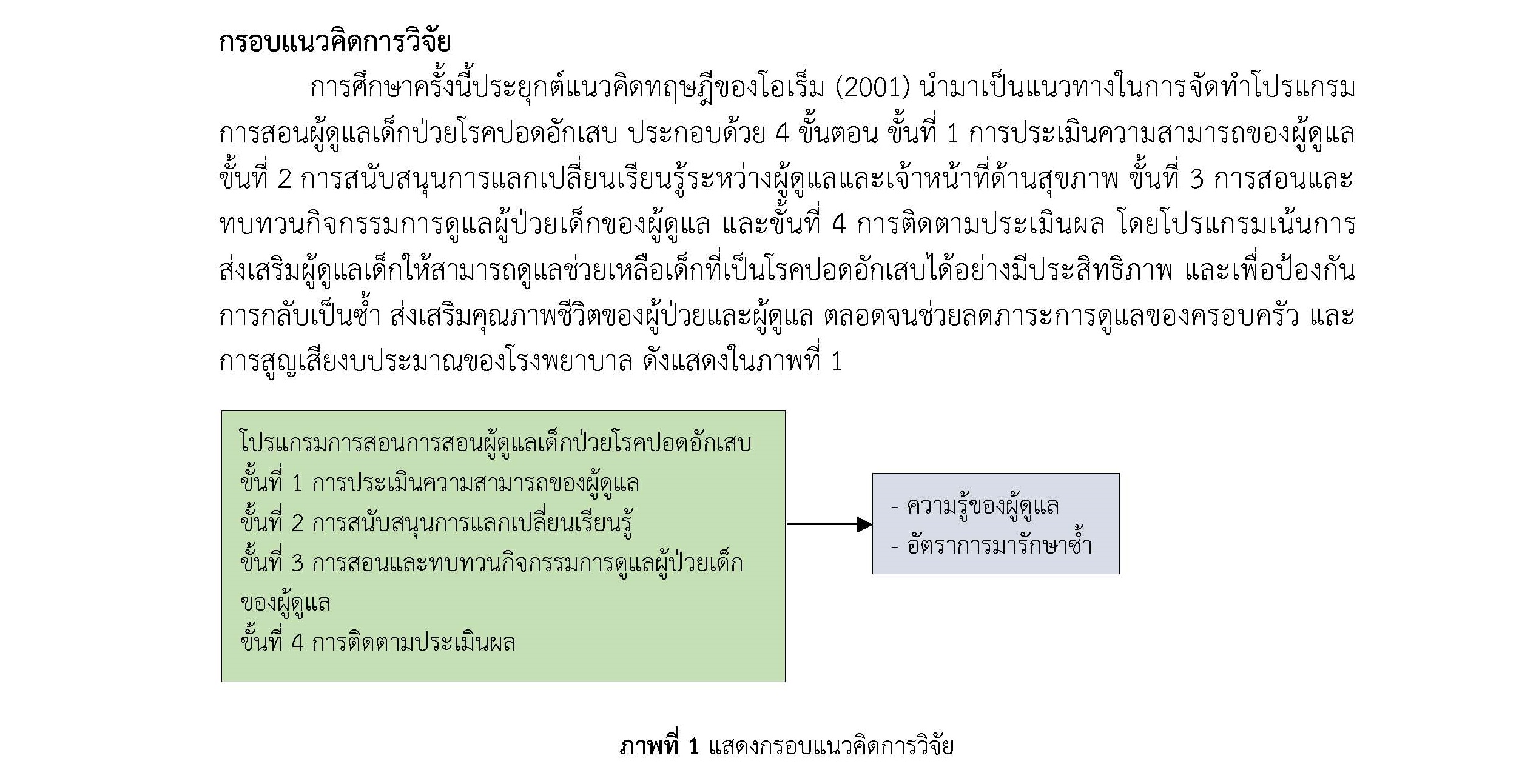The Effects of a Teaching Program on Knowledge Among Pediatric Caregivers and the Recurrence Rate of Pneumonia in a Pediatric Clinic, Narathiwat Ratchanakarin Hospital
Keywords:
Teaching Program, Recurrent Disease, Pneumonia, Pediatric CaregiverAbstract
The objectives of this quasi-experimental study were to examine the effects of an educational program on knowledge among pediatric caregivers and the recurrence rate of pneumonia. Participants were 20 child caregivers and 20 children who were diagnosed with pneumonia in a pediatric clinic at Narathiwat Ratchanakarin Hospital. The research instruments were: 1) an educational program on knowledge among pediatric caregivers and the recurrence rate of pneumonia that was proposed by the concept of Orem (2001); 2) a questionnaire to evaluate the knowledge about pneumonia with correlation coefficients ranging from 0.67 - 1.00; and 3) a self-management skill questionnaire which obtained the Cronbach's alpha coefficient of confidence of 0.99. The data were analyzed using descriptive statistics. The Wilcoxon Sign Rank test was used to compare average scores of knowledge before and after applying an educational program.
The results revealed that after attending an educational program, the mean score of knowledge level among pediatric caregivers was significantly higher than before attending the program. The recurrence rate of pneumonia after applying the program was at 5%. Thus, hospitals and other health agencies can apply or develop this program for their patients in order to reduce the recurrence of pneumonia in pediatric patients.
References
กุลรัศมิ์ ชำนินอก, พัชรภรณ์ อารีย์ และสุธิศา ล่ามช้าง. (2563). ปัจจัยที่เกี่ยวข้องกับการปฏิบัติของมารดาสำหรับการป้องกันการกลับเป็นซ้ำของโรคปอดอักเสบในเด็ก. วารสารพยาบาลสาร, 47(1), 77-87.
แขนภา รัตนพิบูลย์. (2554). การมีส่วนร่วมของผู้ปกครองในการดูแลเด็กป่วยขณะเข้ารับการรักษาใน โรงพยาบาล. รามาธิบดีสาร, 17(2), 232-247.
ฆนรส ม่วงทอง, วราภรณ์ ผาทอง, รัตนาภรณ์ ภุมรินทร์, พิมพิมล ธงยี่สิบ และสมทรง เค้าฝาย. (2554). ประสิทธิผลของโปรแกรมการสอนแบบสาธิตย้อนกลับเพื่อเพิ่มความสามารถของผู้ปกครองในการดูแลทางเดินหายใจผู้ป่วยเด็กโรคปอดอักเสบ. วารสารโรงพยาบาลแพร่, 19(1), 109-116.
ชณาพรทิพย์ รัตนวิชัย และนราทิพ อุดแก้ว. (2561). ปัจจัยทำนายพฤติกรรมมารดาในการป้องกันโรคปอดอักเสบให้บุตรอายุ 0-5 ปี โรงพยาบาลพิจิตร. วารสารโรงพยาบาลพิจิตร, 33(1), 56-67.
ทิพย์ภารัตน์ ไชยชนะแสง, อัจฉรา วริลุน, อุมาสมร หังสพฤกษ์, เอมอร ทาระคำ และภัณฑิรา คำหล่อ. (2562). ผลของโปรแกรมการสอนแนะต่อพฤติกรรมการดูแลของผู้ดูแลผู้ป่วยเด็กโรคปอดอักเสบอายุ 1-2 ปีที่เข้ารับการรักษาในโรงพยาบาล. วารสารการพยาบาลและการดูแลสุขภาพ, 37(4), 206-215.
ปิยฉัตร ปะกังลำภู และเสาวมาศ คุณล้าน เถื่อนนาดี. (2561). ผลของโปรแกรมพัฒนาการรับรู้ความสามารถของผู้ดูแลต่อพฤติกรรมการดูแลและอัตราการกลับมารักษาซ้ำด้วยโรคปอดอักเสบ ในเด็ก 0-5 ปี. วารสารการพยาบาลและการดูแลสุขภาพ, 36(3), 99-106.
ภาวิณี ช่วยแท่น, ภรณี วัฒนสมบูรณ์ และสุปรียา ตันสกุล. (2563). ผลของโปรแกรมสุขศึกษาเพื่อส่งเสริมพฤติกรรมป้องกันการกลับมารักษาซ้ำในมารดาเด็กโรคปอดอักเสบ. วารสารสุขศึกษา, 43(1), 12-24.
โรงพยาบาลนราธิวาสราชนครินทร์. (2564). เวชสถิติคลินิกกุมารเวชกรรม. รายงานประจำปี.
วนิดา แสนพุก, สุดใจ ศรีสงค์ และเพ็ญจุรี แสนสุริวงศ์. (2563). การพัฒนารูปแบบการดูแลผู้ป่วยเด็กโรคปอดอักเสบ. วารสารกองการพยาบาล, 47(1), 153-172.
วิภารัตน์ สุวรรณไวพัฒนะ, รุ่งตะวัน ม่วงไหมทอง, รุ่งทิพย์ เขาโคกกราด, ลูกเกด เสนพิมาย และสาวิตรี พาชื่นใจ. (2559). บทบาทพยาบาล: ความท้าทายในการป้องกันการกลับเป็นซ้ำของโรคปอดอักเสบในเด็กเล็ก. วารสารวิทยาลัยพยาบาลบรมราชชนนี นครราชสีมา, 22(1), 121-130.
สมฤดี เลิศงามมงคลกุล, ไข่มุก วิเชียรเจริญ และอาภาวรรณ หนูคง. (2554). ผลของโปรแกรมการพยาบาลที่เน้นระบบสนับสนุนและให้ความรู้ต่อพฤติกรรมของมารดาในการดูแลบุตรที่ป่วยด้วยโรคติดเชื้อเฉียบพลันระบบหายใจอักเสบ. วารสารพยาบาลศาสตร์, 29(4), 54-60.
สมาคมโรคระบบหายใจและเวชบำบัดวิกฤตในเด็ก. (2562). แนวทางการดูแลรักษาโรคติดเชื้อเฉียบพลันระบบหายใจในเด็ก. กรุงเทพฯ: บริษัท บียอนด์เอ็นเทอร์ไพรซ์ จำกัด.
Abdel Baseer, K. A. & Sakhr, H. (2021). Clinical profile and risk factors of recurrent pneumonia in children at Qena governorate, Egypt. International Journal of Clinical Practice, 75(4), e13695. https://doi.org/10.1111/ijcp.13695.
Dang, T. T., Eurich, D. T., Weir, D. L., Marrie, T. J., & Majumdar, S. R. (2014). Rates and risk factors for recurrent pneumonia in patients hospitalized with community-acquired pneumonia: Population-based prospective cohort study with 5 years of follow-up. Clinical Infectious Diseases: An Official Publication of the Infectious Diseases Society of America, 59(1), 74–80. https://doi.org/10.1093/cid/ciu247.
Faul, F., Erdfelder, E., Lang, A. G., & Buchner, A. (2007). G*Power 3: A flexible statistical power analysis program for the social, behavioral, and biomedical sciences. Behavior Research Methods, 39(2), 175-191.
Orem, D. E., Taylor, S. G., & Renpenning, K. M. (2001). Nursing: Concepts of Practice (6thed.). St. Louis: Mosby.
United Nations Children's Emergency Fund. (2016). UNICEF Data: Monitoring the Situations of Children and Women. Retrieved June 18, 2016. from http://data.unicef.org/childprotection/violent-discipline.html.

Downloads
Published
How to Cite
Issue
Section
License
Copyright (c) 2022 Journal of Nursing and Public Health Research

This work is licensed under a Creative Commons Attribution-NonCommercial-NoDerivatives 4.0 International License.
1. บทความหรือข้อคิดเห็นใด ๆ ที่ปรากฏในวารสารวิจัยการพยาบาลและการสาธารณสุข ที่เป็นวรรณกรรมของผู้เขียน บรรณาธิการไม่จำเป็นต้องเห็นด้วย
2. บทความที่ได้รับการตีพิมพ์ถือเป็นลิขสิทธิ์ของ วารสารวิจัยการพยาบาลและการสาธารณสุข








